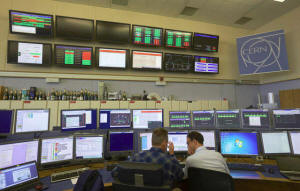|
Physics prepares to feast on collider
data, seeking dark universe
 Send a link to a friend
Send a link to a friend
 [July 06, 2016]
By Tom Miles [July 06, 2016]
By Tom Miles
GENEVA (Reuters) - Scientists at Europe's
physics research center CERN are preparing to unwrap the biggest trove
of data yet from the Large Hadron Collider (LHC), three years after they
confirmed the existence of the elusive Higgs boson.
"In the life of accelerator physics there are few moments like the
one we are living through," said Tiziano Camporesi, leader of the
CMS experiment at CERN.
"This is the time when the probability of finding something new is
highest."
The Higgs boson, whose discovery secured the Nobel prize for physics
in 2013, answered fundamental questions about how elementary matter
attained mass. But it did not solve the riddle of what's missing
from the "standard model" of physics.
The standard model, an elegant ensemble of equations summarizing
everything known about nature, leaves some questions hanging,
Camporesi told Reuters at CERN in Geneva.
One puzzle is why gravity doesn't seem to fit into the standard
model. Another question is why there is far more matter in the
universe that the 4 percent we can see.
 The LHC has never worked better, or harder. Billions of protons
shoot around the 27-km (17-mile) underground ring before smashing
into each other at an energy of 13 Tera electron Volts (TeV), or
about 13 times the force of a flying mosquito. The intensity of the
proton beams has been cranked up to a record, providing more data
than ever.
CERN scientists count their huge volumes of data in "inverse
femtobarns". They harvested 2.6 last year and have culled almost 8
already this year, Camporesi said.
The big reveal will be at the International Conference on High
Energy Physics in Chicago next month when CMS and its neighbor at
CERN, the Atlas experiment, will show what they have found.
[to top of second column] |

Technicians work in the Control Centre of the Large Hadron Collider
(LHC) at the European Organisation for Nuclear Research (CERN) in
Prevessin, France, near Geneva in Switzerland March 11, 2015.
REUTERS/Denis Balibouse

There was a first hint of a possible result last December, when CMS
and Atlas both suggested a "bump" in the data at 750 Giga electron
Volts (GeV).
Within two weeks, there were 89 papers theorizing what it could be.
Now there are 450. But Camporesi urged caution, and said theorists
could be trigger-happy.
"What we have seen is like if you had thrown a coin six times and
see that it always comes out heads. You wouldn’t bet that the coin
has two heads just on that," he said.
"Nature can be kind, or it can be subtle. If it is kind, the
discoveries come quickly."
If it is subtle, it could take all of the LHC's planned 3,000
inverse femtobarns to produce a result.
"I’m afraid that dark matter might be something that is much, much
rarer than the Higgs boson," Camporesi said.
(Reporting by Tom Miles; Editing by Ruth Pitchford)
[© 2016 Thomson Reuters. All rights
reserved.]
Copyright 2016 Reuters. All rights reserved. This material may not be published,
broadcast, rewritten or redistributed.
 |